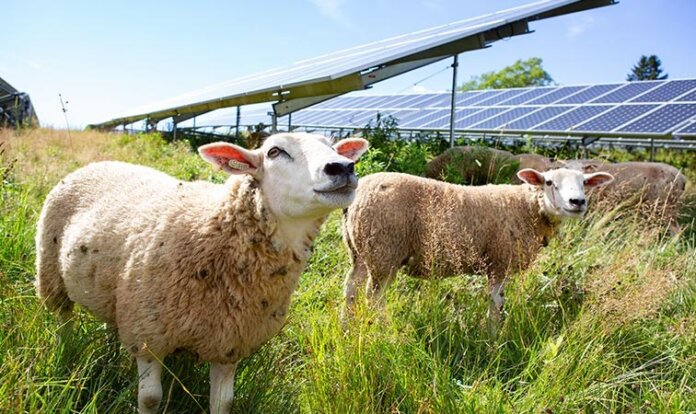
Led by the National Renewable Energy Laboratory (NREL) and funded by the U.S. Department of Energy’s Solar Energy Technologies Office, Innovative Solar Practices Integrated with Rural Economies and Ecosystems (InSPIRE) has completed its second, three-year phase of research into the synergies between solar energy and agriculture.
It is hard to find sheep that are sheltered by solar panels. Lexie Hain, a farmer from the Finger Lakes region in New York, is director of Agrivoltaics for Lightsource.bp. She grazes sheep under solar photovoltaics (PV) panels. Her flocks keep the plants under the rows of PV panels trimmed, saving the installation’s owner the cost of mowing. And Hain’s sheep get to eat for free (and may even be paid for it). This concept—of using PV installations to both create renewable energy and provide space for local agriculture or native habitats—is known as “agrivoltaics.”
“Sheep are late risers. You won’t hear them when you enter the site for an early morning walk. You will hear insects first: little frogs and crickets. It feels alive to you,” says Hain. “The flock loves to lie under the panels, so finding them often involves an element of surprise.”
Both solar developers and those in the local community who care for the land – whether as farmland, rangeland or native habitats – can benefit from agrivoltaics. It is possible to develop low-impact solar projects when all parties understand how they can help each other.
InSPIRE’s first phase attempted to quantify the potential benefits of agrivoltaics, and also record some early best practices. The project takes a big-tent approach in agrivoltaics and welcomes any dual use of solar-occupied space that has agricultural or ecological benefits. This could include grazing livestock or sheep, growing crops or cultivating pollinator-friendly plants or providing ecosystem services and restoring soil.
For InSPIRE’s second phase, NREL and dozens of partnering organizations carried out agrivoltaics field research across the nation to study what makes an agrivoltaics project successful.
“Through our work, which spans multiple regions, configurations, and agricultural activities, we’ve seen so many initial promising results,” states Jordan Macknick, NREL’s lead energy-water-land analyst and principal investigator for the InSPIRE project. “Now, our challenge is to figure out how to scale up and replicate these successes.”
